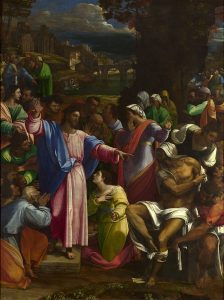Illuminations on the Lectionary readings for March 26, 2023 (Lent 5A)
First Reading: Ezekiel 37:1-14
Our readings change in tone this Sunday as we turn toward Palm Sunday and Holy Week. The metaphorical reflections on temptation, faith and sight that we have heard so far in Lent now move toward explicit ideas of victory over death through resurrection.

The Raising of Lazarus, oil painting on canvas, transferred from wood (1517) by Sebastiano del Piombo (1485-1547). National Gallery, London. (Click image to enlarge)
In our first reading, the prophet Ezekiel imagines a valley filled with dry bones: an eerie and alarming sight. In these poetic verses, God instructs Ezekiel to prophesy, and as he does so, the dry bones become connected, covered with skin, and then breathed to life as a vast multitude. Ezekiel’s prophetic vision reveals God’s promise to restore exiled Israel to its own land, the land that God had promised Moses and the people at Mount Sinai.
Psalm: Psalm 130
Psalm 130 may be most familiar for its use, under the Latin title “De Profundis” (“out of the depths”), as one of the Psalms that the Book of Common Prayer suggests for the burial of the dead. Its hopeful cadences remind us that even in times of grief, pain and despair, we wait in hope for God’s love and grace. Even in death we await the resurrection, as in night’s darkest hours we wait for morning light.
Second Reading: Romans 8:6-11
This passage from Paul’s Letter to the Romans offers a brief glimpse of his continuing examination of the distinctions between flesh and spirit. All of us – even Jesus, as fully human – live embodied lives. But, Paul goes on, the life, death and resurrection of Jesus have given us a new reality: When we accept God’s spirit within us through Jesus, we gain the hope of life, peace and resurrection.
Gospel: John 11:1-45
Why didn’t Jesus hurry back home when he got word that his friend Lazarus was ill? When he finally arrives, his friends Mary and Martha – devastated by the death of Lazarus their brother – confront Jesus separately with the same words: “Lord, if you had been here, my brother would not have died.” Jesus assures Martha, “I am the resurrection and the life. … everyone who lives and believes in me will never die.” Then, when Mary weeps, Jesus weeps with her. And then he goes to the tomb and raises Lazarus from the dead. The crowd looking on is amazed. But the verses that follow immediately after this passage reveal that the priests and temple authorities, fearful that Jesus’ bold acts will bring Roman retribution, decide that Jesus must die.
